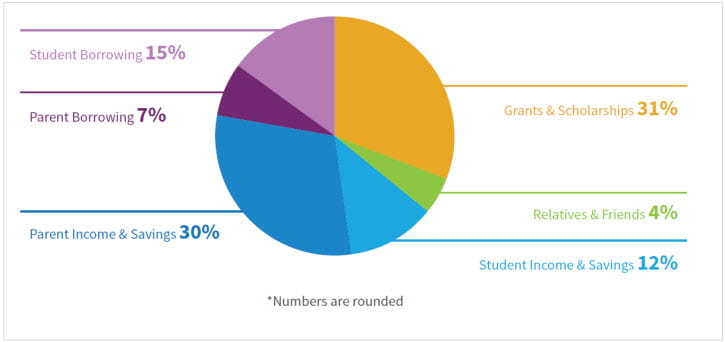During the 2013-2014 academic year, American families paid more out of pocket but borrowed less for college expenses. According to the seventh annual Sallie Mae study, How America Pays for College 2014, both student and parent borrowing decreased by about 5 percent from 2013.
Nearly all of the families (98 percent) believe college is a worthwhile investment for the future. They continue to see the value of college in terms of the tangible benefits (i.e., the ability to earn more money) and as an opportunity for intellectual and social growth. As the report points out, “a college education is becoming a social and cultural norm.”
To help facilitate college enrollment and attendance, more than three-quarters of those surveyed applied for financial aid for the 2013-2014 academic year. However, to cope with rising college costs, rather than increase borrowing, families increased their contributions from income and assets. Student loan disbursement data for 2013-2014 from the National Student Loan Data System (NSLDS) similarly indicates that the percentage of students borrowing has decreased by 4 percent to 5 percent, although the average student loan per recipient has increased slightly. This may be a sign of the ongoing economic recovery.
How the Typical Family Pays for College 2014: Average Percent of Total Cost Paid from Each Source*

Source: Sallie Mae
Additionally, families are utilizing multiple strategies to reduce the cost of college despite the increase in tuition. These cost-savings approaches include attending an in-state school or transferring to a less expensive school, living closer to or at home, adding a roommate, filing for education tax credits, accelerating the pace of coursework, increasing earnings and work hours, choosing an academic major that is marketable and reducing personal discretionary spending to free up more money for college. According to this year’s study, the average family took five actions to help make college more affordable. Parents worry that colleges will increase tuition, interest rates will increase, scholarships and grants will become less available, that their income will decrease due to job loss and that student loan money will become less available.
To further the support the theory of more cost-conscious behavior of college-going families, this year’s survey respondents reported a shift in enrollment from 4-year colleges to 2-year colleges, yielding the highest enrollment in 2-year public colleges since 2007-2008. This may have an impact on Bachelor’s degree attainment, since only about one-fifth of students who intend to obtain a Bachelor’s degree and start off at a 2-year school graduate from a 4-year college with a Bachelor’s degree within 6 years, compared with more than two-thirds of those who first enroll in a 4-year college.
What remains a concern is the small percentage of families who have a financial plan or contingency plan (in the event of unforeseen circumstances) to pay for college. Also a concern is that more families are borrowing money from retirement plans, taking hardship distributions from retirement plans or using home equity loans and lines of credit to pay for college. Credit card utilization as a source of college financing is down. Only 15 percent uses a 529 college savings plan to pay for college.
The survey is based on a telephone poll conducted in April and May 2014 by Ipsos Public Affairs on behalf of Sallie Mae. Survey respondents included 800 undergraduate students age 18-24 and 801 parents of undergraduate students age 18-24. The overall margin of error is +/- 2.5 percentage points at the 95 percent confidence level.







